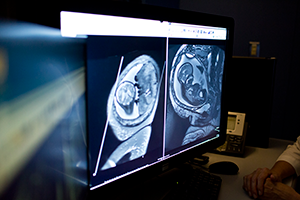Using fMRI for assessment prior to neurosurgery

For more than 20 years, Children’s National has explored the use of non-invasive fMRI as an alternative to more invasive testing to assess children’s language and memory.
A new Practice Guideline Summary published in Neurology, the journal of the American Academy of Neurology, contains the first complete, objective assessment of available data on the efficacy of functional magnetic resonance imaging (fMRI) to assess baseline language and memory, brain hemisphere dominance and to predict postsurgical impacts prior to surgery in patients with epilepsy.
According to contributing author William D. Gaillard, M.D., chief of Child Neurology, Epilepsy and Neurophysiology, and director of the Comprehensive Pediatric Epilepsy Program at Children’s National Health System, the report outlines several cases in which fMRI presents an effective alternative to the current standard of care, intracarotid amobarbital procedure (IAP). In IAP, medication is injected through the carotid artery to isolate one hemisphere of the brain at a time, followed by the patient performing memory or language tasks. The approach requires catheterization via a major artery. While minimally invasive, the procedure still carries the standard risks of vascular catheter procedures and requires recovery time.
“This publication took six years to complete,” Dr. Gaillard notes, “but we are happy to finally have the practice parameters that will make the case for the use of fMRI in an evidence-based way.”
Though the Practice Guidelines focus on adults, the evidence assessment included all available pediatric data as well, says Dr. Gaillard. A great deal of that data were contributed by Children’s National faculty, who lead the nation in clinical applications of fMRI. More than 20 years ago, Dr. Gaillard and his team began studying fMRI as a viable alternative to IAP to collect accurate language assessments in children, particularly those with epilepsy. Today, Children’s National is at the forefront of clinical application of fMRI, having performed about 1,000 pediatric assessments in the last two decades — more than nearly every other institution.
An 11-member panel of international experts conducted the analyses for the Practice Guidelines. Overall, the report indicates:
- fMRI is a viable option for measuring lateralized language functions in place of IAP in medial temporal lobe epilepsy, temporal epilepsy in general or extratemporal epilepsy.
- Evidence was insufficient to recommend fMRI over IAP for patients with temporal neocortical epilepsy or temporal tumors.
- Pre-surgical fMRI can serve as an adequate alternative to IAP memory testing for predicting verbal memory outcome.
In closing, the authors also explicitly recommend that clinicians carefully advise every patient of the risks and benefits of both fMRI and IAP before recommending either approach.
Related resources: Use of fMRI in the presurgical evaluation of patients with epilepsy










